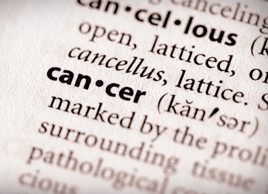Can you catch cancer?
A growing body of scientific research suggests that some cancers are triggered by undiagnosed, untreated infections. Here’s what you need to know about "catching" cancer

Source: Adapted from Reader’s Digest, July 2010
For years, we’ve thought cancer was caused by lifestyle choices (fatty diet, smoking, lack of exercise), environmental factors (pollution, radiation, ultraviolet light) or genetic mutations. But now scientists have discovered that infections’produced by viruses, bacteria or parasites’can trigger some cancers. Insidious and symptomless, these infections fester quietly and produce cellular changes that can result in malignancies. Until now, people often were unaware that anything was amiss, so they didn’t seek treatment.
Usually, these infections alone don’t lead to malignancies. The standard trio of risk factors’lifestyle, environmental, genetic’may also be needed. But because we now know that some cancers won’t develop without the underlying infection, we have a whole new cancer-prevention strategy: Get tested (and cured) for any of these infections, or get vaccinated to avoid them in the first place.
HPV
In the early ’70s, Dr. Harald zur Hausen announced a radical idea at a scientific conference in Key Biscayne, Fla.: Human papillomavirus (HPV), which can cause genital warts, was the culprit behind cervical cancer. No one believed him. But zur Hausen, now an emeritus professor at the German Cancer Research Centre in Heidelberg, was on a mission to get to the bottom of the disease, which kills almost 300,000 women annually around the world. ‘I was convinced I was on the right track, although I knew it would require a lot of additional work to prove it.’ There were many strains of HPV‘some relatively harmless and others quite dangerous’so it was only after the molecular analysis of thousands of warts that a breakthrough came, in 1984. That’s when zur Hausen realized that just two strains of the virus’HPV 16 and 18’were found in 70 percent of cervical cancers.
At the end of 2006, a vaccine was approved in 49 countries, including Canada. Since HPV is transmitted sexually, the ideal time for girls to get the vaccine is before they become sexually active. So far, more than 40 million doses of the vaccine have been distributed worldwide.
Cervical cancer is slow-growing, and it will take years before the full benefit of the vaccine is known. However, a February 2010 study of more than 17,000 women in Bogotá showed that getting the vaccine reduced the number of cervical abnormalities related to HPV 16 and 18 by more than 90 percent.
Trichomoniasis
Lorelei Mucci, an epidemiologist and assistant professor of medicine at the Harvard School of Public Health, recently completed a study of the link between sexual infection and prostate cancer. Results from the more-than-1,300 subjects showed that exposure to the common sexually transmitted infection trichomoniasis nearly triples a man’s risk of developing a particularly aggressive, lethal form of prostate cancer.
Caused by a parasite’Trichomonas vaginalis’the infection ‘is silent in women,’ Mucci explains. It rarely causes symptoms in males, either. ‘It lasts for a very long time,’ she says. ‘And it causes chronic inflammation, which damages cells and tissue, leading to precancerous changes.’
If this association is confirmed by further research, some forms of prostate cancer could be prevented with a short course of antibiotics. ‘People used to believe trichomoniasis was not a serious disease,’ Mucci says. ‘We now know we should be concerned about its long-term effects.’
Worldwide, about 250,000 men die of prostate cancer every year; about four percent of American men develop an aggressive form of the disease.
Hepatitis B
In the early ’70s, a young American named Dr. R. Palmer Beasley was studying hepatitis B in Taiwan, where rates of the disease were high. Beasley was working at a research facility established by Seattle’s University of Washington. While learning how the disease was transmitted’from mother to newborn, among other ways’he came to realize that Taiwan also had an unusually high incidence of liver cancer. After more research, he postulated that hepatitis B caused the cancer. ‘People thought I was crazy,’ recalls Beasley, now a professor of epidemiology at the University of Texas, in Houston. ‘I was told it was nonsense. The vision then was that the big answers would come from chemicals.’
But Beasley persisted and, in 1975, began a landmark study that eventually showed liver cancer occurred almost exclusively in people who had been infected with hepatitis B‘the majority of whom were carriers with no symptoms of liver disease.
Normally, liver cancer is fatal, killing almost 700,000 people every year. But now we can thwart it. Last year, a study showed that six-to-19-year-olds in Taiwan who received the hepatitis-B vaccine at birth had a 70-percent-lower risk of developing liver cancer than did those who weren’t vaccinated at birth.
Cervical, stomach and liver cancers are the major ones triggered by infection. But less common ones’including those of the immune system (Burkitt’s lymphoma and Hodgkin’s disease), the larynx, the esophagus, the skin (Kaposi’s sarcoma and Merkel cell carcinoma)’arise the same way. ‘Globally, 21 percent of cancers are linked to infection,’ says the German Cancer Research Centre’s Dr. zur Hausen. ‘This exceeds even the incidence of cancers linked to smoking, which is 18 percent globally. I suspect we’ll find more.’
This article was originally titled "Can You Catch Cancer?" in the July 2010 issue of Reader’s Digest.




